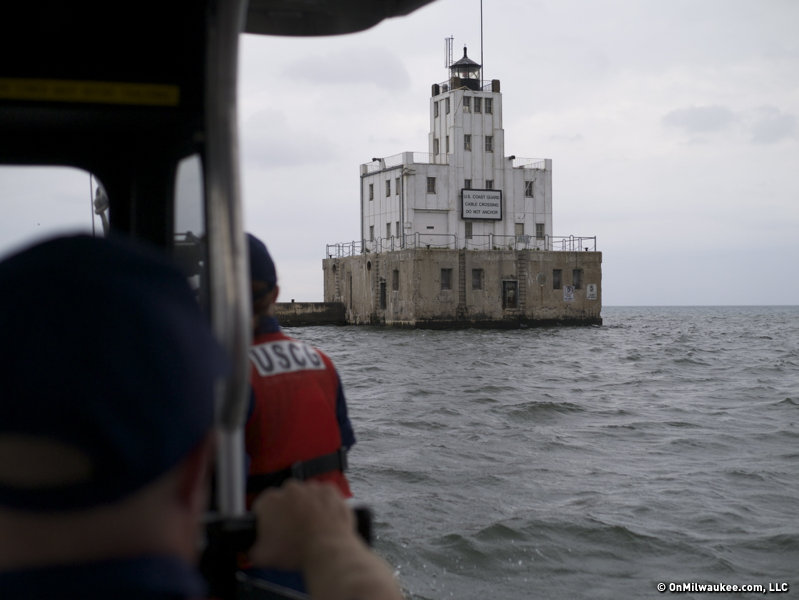Do you ever wonder what it was like for the men who landed on the moon to stand on the cratered surface and look back at the Earth; to know the feeling of being out at a place that everyone can see but that no one gets to visit and look back from?
I imagine it’s much like a visit to the breakwater lighthouse felt – though obviously to the Nth degree – on a recent trip out there on a Coast Guard Aids to Navigation boat.
The lighthouse, with its five-story tower, is visible at the harbor entrance, on the tip of the northern swoop of the four-mile breakwater that protects Milwaukee’s harbor, and most everyone in Milwaukee has seen it from Summerfest or from atop the Hoan Bridge or from an office in a Downtown building or from Veteran’s Park or out a Prospect Avenue condo window.
But very few have actually had the opportunity to stand atop its concrete foundation or peer out at the skyline from the top of its tower. So, of course, I had to try.
Though the art deco lighthouse, built in 1926 and automated 40 years later, is off-limits to the public, it is among the many lighthouses of which the the federal government is attempting to divest itself.
That made a visit possible.
So, Jon Grob, BOSN3, of the Waterways Management and Aids to Navigation division of the U.S. Coast Guard’s Sector Lake Michigan – of which the Bay View station is headquarters – worked his magic and made it happen.
The lighthouse was deemed excess property in 2011 and, as has been happening all around the Great Lakes, the government is trying to ink a long-term lease for the place, which was added to the National Register of Historic Places in September 2011.
"It’s a long-term lease," Grob told me as we waited for a boat out behind the Bay View Coast Guard station. "It’s like a 10-year lease and it comes up for renewal. And then they have to maintain insurance. It’s a long process."
He also says it’s a complicated process.
"We still work on 42 (lighthouses) and almost all of those have been divested. We’re trying to divest this one here, too. It’s been advertised. It is (difficult) because it’s big, it’s very expensive to keep it up. Painting, maintenance, changing out windows.
"Because they’re all historic, it’s very expensive. You have to match the same kind. The state historic preservation offices have a say in what we can do. We can’t just go on a lighthouse, even if it’s completely owned by the government, and change stuff. To put a solar panel on it, we need permission."
You’d think nobody would want to take it on. After all, there is no way to get to the lighthouse other than by boat. And when we arrived, it was clear that even that mode of transportation isn’t without hurdles.
While the 10- or 15-minute ride out there is pleasant – despite the storm that rolled in bringing wind and rain – and offers great views of the city, there is no dock at the lighthouse. You have to pull up alongside and climb a metal ladder up the side of the foundation. The water around the lighthouse gets pretty choppy, so the boat is bobbing pretty good in the drink. I’d have been leery about if I wasn’t with a half-dozen Coast Guard personnel.
So, who is the target lessee?
"If somebody wanted to make a museum out of it," says Grob. "Or if a group of people got together and said, 'we love this lighthouse’ and they form Lovers of the Milwaukee Lighthouse. Like they did in Wind Point. They have a beautiful lighthouse there and they have a group of people that maintain it and keep it up and the government gives them a deed and on the deed it specifies, ‘you shall make this accessible to the public or make this a museum.’"
In fact there is a group, called Milwaukee Breakwater Lighthouse Friends and on its website, the group notes that a nonprofit submitted a letter of interest that is currently under review.
According to Grob, the application has been received and "viewed favorably and the initial forwarding is in process."
He adds that the process is a long one and finalization of a deal wouldn't likely occur before 2014.
When we arrived at the base of the lighthouse – the breakwater is owned by the Army Corps of Engineers, though the lighthouse itself is administered by the Coast Guard – a couple sailors climbed the ladder and went around to open a door in the foundation from the inside, saving the rest of us the roughly 15-foot climb up.
Once through the door, we were in the base upon which the lighthouse sits. It’s dark in this space, which has four or five smallish rooms that likely served as the offices and perhaps storage. There are some windows here, but most are sealed up.
When we walk in, the Coast Guard personnel, who visit the place at least once a year, were surprised to see a plaster ceiling had fallen. This crew knows the lighthouses pretty well, says Grob.
"I’ve (only) been out there maybe three times (in five years)," he says. "These guys work them every year. They have to go out and physically inspect them. They check the wiring, the lights, the sound signal. They have specific testing they have to. If there are batteries they have to do load testing on the batteries. Whatever the cycle of inspection is required, that’s what they’ll do."
He makes a note of the damage, so it can be reported to the engineering and repairs departments and we head upstairs.
The main part of the lighthouse has two stories with four to six rooms on each floor. On the first floor was a kitchen, living room, dining room and a boat room, with a big "garage door" that opened to pull a boat in. On the second floor were four bedrooms, a bathroom and some closets. Other than some plumbing – and walls and floors, of course – almost nothing remains of the rooms.
There’s plenty of space in the structure, but it’s not in very good shape on the inside. Plaster has fallen from spots in the ceilings and walls, the floors – most likely hardwood later layered with tiles from what was can see – have been almost entirely removed, though subfloors remain.
"Not that long ago, maybe 25-30 years ago, we had people living in them, maintaining them," Grob says. "I knew a guy that he and his family, that was his job. He was active duty Coast Guard and he lived in the lighthouse and took care of it ... put gas in the generators and made sure the light was going.
"In Racine they used to have a big lighthouse. It’s the neatest one I’ve ever seen. It looked like an old Tim Burton movie lighthouse. They used to bring guys out there and they’d stay. There were times they couldn’t get to them because of weather and in the winter it freezes."
There’s no power these days and according to a log book we discovered just below the light, in the square, two-story tower, the lighthouse was converted to solar power on Oct. 16, 2008. The light and the foghorn are run off solar panels that sit out on the third-story deck, facing out toward the lake.
While things look rough inside, the guts of the lighthouse look like they’ll easily make another couple hundred years. The house itself is riveted steel atop a massive concrete foundation resting on a concrete slab that sits on three reinforced concrete caissons. It’s not going anywhere.
At the tip-top, of course, is the red light you can see every night. There’s also a NOAA weather station on the lighthouse, and just outside the circular space containing the light is the foghorn, which, believe it or not, isn’t controlled by the Coast Guard, but by boaters out on the lake, who can use their radio to activate it and warn other craft of fog.
I remember my days living on the East Side, lying in bed in summer and listening the throaty groan of the fog horn. Despite its unassuming visual aspect, seeing it was one of the highlights of the trip for me.
Needless to say, the views of the Milwaukee skyline are pretty awesome. But so is the view to the east, where Lake Michigan sprawls out as far as the eye can see to the north, east and south. It’s a serene, yet powerful landscape.
But the views might not be enough of a draw to get this place divested. While there were none of the bats or other wildlife I’d been warned to expect, the place is pretty rough inside (and don’t forget the trip). But Grob is optimistic.
"There was quite a bit of maintenance we did before we divested them," Grob says of other lighthouses. "Now they have them officially under deed. They’re going to make them just absolutely phenomenal.
"Lighthouses are wonderful. They really are. They’re so historic to the lakes because they were so important to the shipping. And they go back and they’re all unique. Very few, if any around here, are the same."
Born in Brooklyn, N.Y., where he lived until he was 17, Bobby received his BA-Mass Communications from UWM in 1989 and has lived in Walker's Point, Bay View, Enderis Park, South Milwaukee and on the East Side.
He has published three non-fiction books in Italy – including one about an event in Milwaukee history, which was published in the U.S. in autumn 2010. Four more books, all about Milwaukee, have been published by The History Press.
With his most recent band, The Yell Leaders, Bobby released four LPs and had a songs featured in episodes of TV's "Party of Five" and "Dawson's Creek," and films in Japan, South America and the U.S. The Yell Leaders were named the best unsigned band in their region by VH-1 as part of its Rock Across America 1998 Tour. Most recently, the band contributed tracks to a UK vinyl/CD tribute to the Redskins and collaborated on a track with Italian novelist Enrico Remmert.
He's produced three installments of the "OMCD" series of local music compilations for OnMilwaukee.com and in 2007 produced a CD of Italian music and poetry.
In 2005, he was awarded the City of Asti's (Italy) Journalism Prize for his work focusing on that area. He has also won awards from the Milwaukee Press Club.
He has be heard on 88Nine Radio Milwaukee talking about his "Urban Spelunking" series of stories, in that station's most popular podcast.







